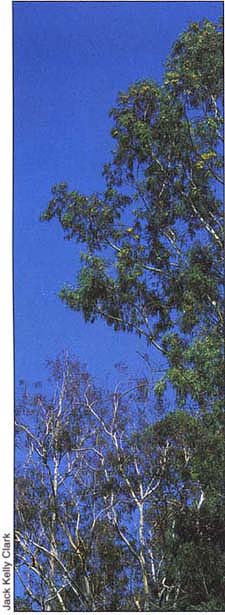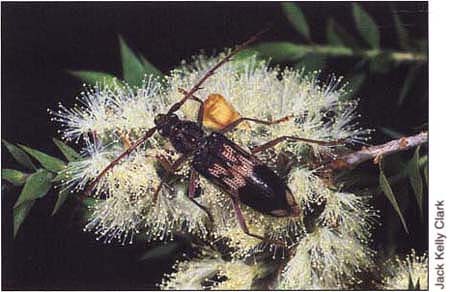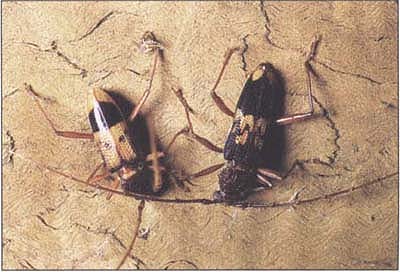All Issues
Californians love, and hate, eucalyptus
Publication Information
California Agriculture 50(3):6-7.
Published May 01, 1996
PDF | Citation | Permissions
Full text
More than a century ago, California naturalists began planting Australian eucalyptus out of a simple fascination with the exotic. At the turn of the century, a national hardwood famine spurred the trend. Entrepreneurs touted the trees for virtually very use, from railroad ties to housing construction.
Although UC Berkeley scientists disproved most of these claims by 1913, the fast-growing trees were already thriving across the state. Today various eucalyptus species populate virtually every lowland area of California.
Perhaps because of its vigorous growth, eucalyptus has gained a checkered reputation since its first introduction in 1853. Some appreciate its aesthetic value (it is frequently used as landscape and highway foliage, particularly as a windbreak) or value it for hardwood production. Others fear its potential to fuel hot fires and dislike its tendency to crowd out native species.
However one feels about eucalyptus, its contribution to the California landscape is today threatened by the recent accidental import of Aussie pests. Over the last decade, three major eucalyptus pests have caught up with their hosts. In 1984, the eucalyptus longhorned borer (ELB), Phoracantha semipunctata, was found in Orange County, in 1991 blue gum psyllid was found in Monterey County and in 1994 the eucalyptus snout beetle arrived in Ventura County.
Eucalyptus trees are now under attack by another Australian pest, P. recurva, also known as the “yellow phoracantha.” UC Riverside entomologist Lawrence Hanks says, “Our South African colleagues report that P. recurva has a preference for ovipositing on the larger branches, whereas ELB prefers the trunk. So together they deliver a one-two punch to eucalyptus trees.” Hanks and two other UC Riverside entomologists, Jocelyn Millar and Tim Paine, have conducted studies showing a stingless wasp can effectively parasitize ELB eggs (see page 14 ). Fortunately, Hanks says, Avetianella longoi also parasitizes the eggs of P. recurva.
The researchers are also studying Anaphes nitens, a stingless wasp from South Africa that parasitizes the eucalyptus snout beetle.
Since its first planting in 1853, eucalyptus has aroused controversy. Many naturalists don't like the aggressive nonnative species because they crowd out native plants and drop a lot of litter that fuels urban forest fires.
“There are extremely volatile chemicals in the composition of eucalyptus,” says Russell Beatty, private landscape consultant and senior lecturer emeritus at UC Berkeley. “They also create their own kindling — they drop leaves, peel bark and drop limbs. Old eucalyptus groves have dead, stringy bark that can lead flames to the crown.” This is especially a problem in late summer when the moisture level drops rapidly and before the rains begin.
Another problem is “sudden limb drop syndrome,” an unpredictable phenomenon occurring in warm, dry, calm weather.
“Simply because of their scale, blue gum and similar species are difficult to live with in residential areas,” Beatty noted.
On the other hand, eucalypts are popular because drought- and salt-tolerant species will thrive where other tree species won't grow. The trees are also grown for use as biomass, pulp-wood and firewood.
The eucalyptus is a symbol of Mills College in Oakland. Several thousand eucalypts were planted on its campus in the 1870s. “They are an important part of the sense of the college,” says David Johnson, landscape architect and Mills College facilities director. “The large campus buildings are set in groves of towering trees, these surround open meadows, which provide a unique sense of place.”
To protect the stately groves from eucalyptus longhorned borers, Johnson is working with Hanks to release parasitic wasps. An evaluation of the infestation indicated that without intervention Mills College would have to remove several hundred trees over the next 5 years. “It would cost $1,500 to $2,000 apiece to take down and grind down infested trees,” Johnson says, explaining the expense would include renting cranes because many of the college's trees are planted close to buildings or on steep hillsides.
The East Bay Regional Park District is trying to preserve eucalyptus in places such as Ardenwood, where they have historic significance, and at Point Pinole, which is a bivouac for monarch butterflies. The district is removing trees infested with eucalyptus longhorned borer. “At the two sites, the district has taken out 800 trees over 2 years due to borer infestation,” says Nancy Brownfield, the district's Integrated Pest Management specialist. “We look at each setting where there's a problem to see if there is a good reason other than horticultural to preserve them, whether trees are serving another purpose.”
Eucalyptus is also a good source of firewood, producing a great deal of heat. “It ranks at the top for energy value, says Ralph Carhart, Caltrans landscape architect in Sacramento. “A lot of landowners clear native oaks and make economic use of them by selling them as firewood. Using eucalyptus as firewood eases cutting of native hardwoods.”
Caltrans plants eucalypts as windbreaks and for urban ornamental use. “There are certain places where we don't have a lot of dry-land trees that eucalypts have been a backbone to the landscape,” says Carhart.
But those abilities to grow quickly and in difficult situations can also make it a nuisance. Eucalyptus can encroach into native habitats, displacing native species, notes Mark Wisniewski, project director of the Encinitas-based Cottonwood Creek Conservancy. “It can be very aggressive and shade out native plant species,” says Wisniewski. “The dense leaf and bark litter of eucalyptus can smother less aggressive native plants and seedlings.” He points to the example in Angel Island where the Park Service had to remove the prominently planted eucalyptus to allow native plants to become re-established.
A lot of people associate eucalyptus with old blue gum trees, but Carhart says there are several dozen species growing in California that range from massive to small manageable trees, each with unique characteristics. Eucalyptus ficifolia is a small tree with beautiful red flowers that grows in coastal communities. In Southern California, there's the tall, graceful, slender smooth-barked E. citidora. The East Bay Area has E. sideroxylon, which features rough, dark reddish-brown bark and leaves with a purplish cast. The tall E. cladocalyx softens San Diego's skyline with clouds of foliage.
“We still continue to plant some eucalyptus, primarily in urban landscapes,” Carhart says. “We used to plant thousands every year, but their use has declined in relation to other plant materials. The trend here in the [Central] Valley is to focus on oaks and other native trees. Natives are better culturally adapted to pests, soils and climate.”
The eucalyptus longhorned borer has killed thousands of eucalyptus trees. Feeding on the tree's cambium, the larvae can destroy a tree in just a few weeks.
Linda Romero, urban forester for the California Department of Forestry and Fire Protection in Southern California says, “As a naturalist, I tend to be pro-native plants and ecosystems. But at same time, as an urban forester I advocate planting nonnatives to make life more comfortable for humans.” She favors planting eucalypts in desert areas, where other tree species are not well suited.
Eucalyptus trees are now under attack by another insect species, P. recurva, also known as the “yellow phoracantha.”
A study conducted in Atlanta illustrates the value of trees in developed desert areas. Romero says researchers found that urban development drove up temperatures 10 ° to 12°F.
“Carbon and particulates trap heat in the atmosphere, exacerbating hot temperatures,” she explains. “When you plant trees, you provide shade, cooling the environment and the trees act as carbon shed, absorbing carbon and cleaning the atmosphere.”
It bothers Beatty to see what he calls a “knee-jerk reaction” by some who would get rid of eucalyptus trees without considering the consequences. Although any agency or institution that wants to get rid of eucalyptus trees can get an area logged for free in exchange for the timber, Beatty warns that there is a hidden cost: pampas grass, Scotch broom, French broom and cotoneaster, which also create fire hazards, often move in. “These invasive woody plants fill in, crowding out native trees that have a difficult time competing,” Beatty explains. “Before you remove eucalyptus trees, you have to address the question, ‘What do we do next?’”
Ultimately, the experts agreed that the value of any tree species is based on suitability, planting the right tree in the right place.
“Eucalyptus, from my perspective, is not a bad tree and shouldn't be eliminated,” Romero says. “It should be used judiciously where it grows best and along with other species.”
— Editor







